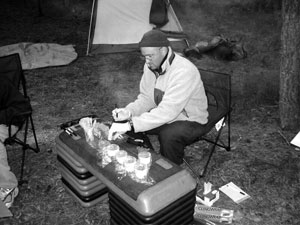
In this issue:
- Work/rest issues
- Assignment length
- Shift length
- Fatigue countermeasures
Background
This report, the fifth in a series, reviews activities related to the Missoula Technology and Development Center (MTDC) project on wildland firefighter health and safety. The project focuses on three main areas:
Work/rest issues
Development of an objective approach for the determination of
work/rest standards and recommended assignment lengths for crews and
overhead teams
Energy and nutrition
Improvement of the energy intake, nutrition, and immune function of
wildland firefighters
Fitness and work capacity
Implementation of work capacity and medical standards, and improvement
of the health, safety, and productivity of firefighters
This report focuses on work/rest issues with special attention to shift length, length of assignment, rest/sleep guidelines, and fatigue countermeasures. Other work/rest issues include rest breaks, nutrition, hydration, and topics related to performance and fatigue. Earlier reviews of studies in this area (Sharkey 1980, Jukkala and Sharkey 1989) indicated that a number of factors influence workers’ ability to maintain performance for extended hours, days, or weeks of work. Physically fit and motivated workers are able to perform for extended periods when the work is meaningful and the goal is worth attaining. In contrived or make-work studies, performance declines precipitously with time. Studies by MTDC show that workers perform above expectations when they are trained, motivated, and part of a cohesive group, such as a type 1 fire crew.
Work/rest issues are confounded by economic, personal, and social concerns. Changes in assignment or shift length may affect firefighters’ income. Family concerns also influence the desirability of extended assignments. While these issues are important to the successful implementation of policy, they are outside the scope of this project.

University of Montana researcher Dr. Brent Ruby
rises early
to collect immune
function and
fatigue data
in fire camp (see page 7).

